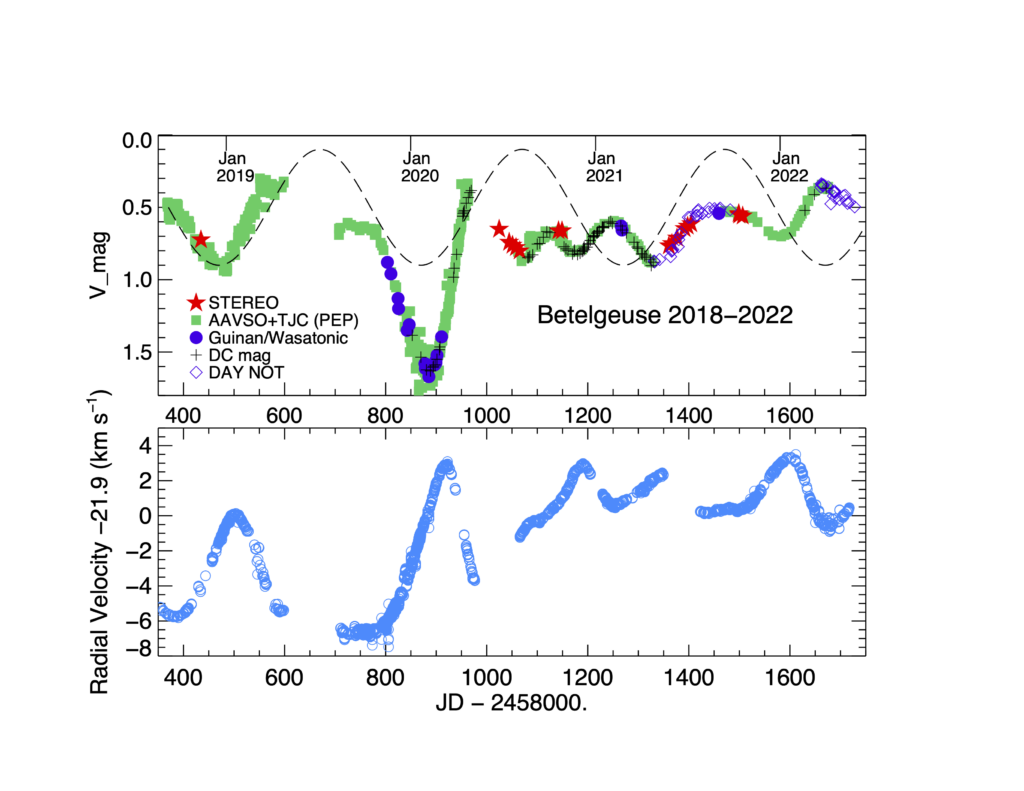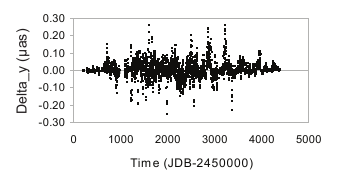Title: The Great Dimming of Betelgeuse: a Surface Mass Ejection (SME) and its Consequences
Authors: Andrea K. Dupree, Klaus G. Strassmeier, Thomas Calderwood, et al.
First Author’s Institution: Harvard & Smithsonian Center for Astrophysics
Status: Open access in ApJ
Everything tends to fall apart with age. The same is true of stars. Massive stars live for orders of magnitude less time than their less massive cousins, and in the last hundreds of thousands of years of their lives, their bodies age dramatically. They become very swollen. Their hydrogen outer layers fly off, exposing the byproducts of CNO cycle fusion that lie within. They cough up dust, deform from their spherical shape, and tremble and shiver. Wracked by the ravages of time, they are no longer recognizable as the O-type main-sequence stars they once were.
Most well-known of these dying high mass stars is perhaps the red supergiant Betelgeuse, famous as the shoulder of the constellation Orion and for “the Great Dimming,” when it reached a record low in brightness between January 27 and February 13 in 2020. The authors of today’s paper catalog the changes in the star during this period, like doctors monitoring the progress of a patient presenting with mysterious symptoms.

Reviewing Medical History
Betelgeuse is known already to be a highly variable and dynamic star, roughly 1000 times larger than the Sun in radius. Figure 1 shows the light curve of the star, which plots the brightness of the star’s emission over that time, and the radial velocity curve of the star, which plots the velocity of the star’s surface along the line of sight (such as whether it is moving towards or away from the observer). From the light curve, one can see that it has a pulsation period of ~400 days. In addition to pulsating, Betelgeuse roils with enormous convection cells that bubble out from its surface (see figure 2).

Like all stars, Betelgeuse possesses a photosphere–the surface from which the star’s visible light emerges-and a chromosphere just above that, a lower atmosphere where emission lines are produced. The strength of the absorption lines from the photosphere track the star’s temperature, as do the ratios of strengths between different emission lines in the chromosphere. The profiles of these lines can also be used to measure velocity changes in the star’s layers. The outermost atmosphere of Betelgeuse creates radio waves by the acceleration of free electrons by atomic nuclei. This allows radio observations to measure the temperature of the electrons.
Monitoring the Vital Signs
Images of Betelgeuse at the beginning of January 2019 looked roughly circular and evenly lit; in other words, normal. But starting around that time, the photosphere exhibited the signs of a shock wave along the line of sight, starting to expand at an outward velocity of roughly 8 km/s, and continued to show this until mid-November. Emission lines in the lower chromosphere showed asymmetric profiles, indicative of outflowing plasma. The outer layers of the chromosphere, however, remained apparently undisturbed from January 2019 to March 2019.
Absorption lines from the photosphere weakened between April 2019 and February 2020, indicating a decrease in its temperature of about 200 Kelvin. However, this temperature change was not enough to explain the star’s great dimming, suggesting that obscuration by dust also had to play a role. Optical spectra from February showed increased turbulence in the star’s photosphere. After the photosphere and chromosphere were observed to be disturbed, radio observations in August 2019 indicate the outer atmosphere of Betelgeuse cooled. This could be caused by an expansion of the gas, leading it to cool down. In December 2019, optical imaging of the star revealed the southern hemisphere had dimmed so much it looked like it disappeared.
The Expert Diagnosis
Altogether, the observations suggest an eruption in the surface of Betelgeuse that then traveled outward, cooling the photosphere in its wake and then driving the atmosphere of the star to expand. But what kind of eruption? The Sun undergoes coronal mass ejections (CMEs)–great fireballs of plasma that get flung outward by the release of magnetic energy. After such a CME, the sun’s corona and chromosphere dim, and decrease in density and temperature. But Betelgeuse is not known to have magnetic eruptions like the Sun; it has only weak and wishy-washy fields. It does, however, have those massive convection cells that bulge out from the star. A particularly vigorous one must have forced the photosphere of the star outward to the point that it escaped into space from Betelgeuse’s low surface gravity, which is 104 times lower than the Sun’s. The ejecta pushed aside anything in their way, leaving behind a low density, cooler, and dimmer wake. The stellar secretions then condensed into dust, further reducing the amount of light observers could see from the star.
The outburst seems to have been traumatic to Betelgeuse. Observations taken after the Great Dimming show that the star’s 400-day pulsation period is gone. Brightness minima are now separated by varying values much shorter than the former period, like an irregular heartbeat. The authors conclude that the entire star is adjusting to the disturbance created by the surface mass ejection. However, despite these obvious signs of ill health, Betelgeuse still has a while before it goes supernova, about 100,000 years. While the massive stars die young, they still live an incredibly long time on human timescales.
Astrobite edited by Evan Lewis, Macy Huston, and Lili Alderson
Featured image credit: Lynnie Saade




